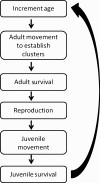Weighing the relative potential impacts of climate change and land-use change on an endangered bird
- PMID: 27386089
- PMCID: PMC4930994
- DOI: 10.1002/ece3.2204
Weighing the relative potential impacts of climate change and land-use change on an endangered bird
Abstract
Climate change and land-use change are projected to be the two greatest drivers of biodiversity loss over the coming century. Land-use change has resulted in extensive habitat loss for many species. Likewise, climate change has affected many species resulting in range shifts, changes in phenology, and altered interactions. We used a spatially explicit, individual-based model to explore the effects of land-use change and climate change on a population of the endangered Red-cockaded Woodpecker (RCW; Picoides borealis). We modeled the effects of land-use change using multiple scenarios representing different spatial arrangements of new training areas for troops across Fort Benning. We used projected climate-driven changes in habitat and changes in reproductive output to explore the potential effects of climate change. We summarized potential changes in habitat based on the output of the dynamic vegetation model LPJ-GUESS, run for multiple climate change scenarios through the year 2100. We projected potential changes in reproduction based on an empirical relationship between spring precipitation and the mean number of successful fledglings produced per nest attempt. As modeled in our study, climate change had virtually no effect on the RCW population. Conversely, simulated effects of land-use change resulted in the loss of up to 28 breeding pairs by 2100. However, the simulated impacts of development depended on where the development occurred and could be completely avoided if the new training areas were placed in poor-quality habitat. Our results demonstrate the flexibility inherent in many systems that allows seemingly incompatible human land uses, such as development, and conservation actions to exist side by side.
Keywords: Development; HexSim; Picoides borealis; Red‐cockaded Woodpecker; environmental stress; habitat change; habitat loss; population model; precipitation; spatially explicit individual‐based model.
Figures



Similar articles
-
Land use compounds habitat losses under projected climate change in a threatened California ecosystem.PLoS One. 2014 Jan 21;9(1):e86487. doi: 10.1371/journal.pone.0086487. eCollection 2014. PLoS One. 2014. PMID: 24466116 Free PMC article.
-
Differentiating the effects of climate and land use change on European biodiversity: A scenario analysis.Ambio. 2017 Apr;46(3):277-290. doi: 10.1007/s13280-016-0840-3. Epub 2016 Nov 1. Ambio. 2017. PMID: 27804097 Free PMC article.
-
The relative effects of habitat loss and fragmentation on population genetic variation in the red-cockaded woodpecker (Picoides borealis).Mol Ecol. 2010 Sep;19(17):3679-91. doi: 10.1111/j.1365-294X.2010.04659.x. Epub 2010 Jul 7. Mol Ecol. 2010. PMID: 20618895
-
Facilitating climate-change-induced range shifts across continental land-use barriers.Conserv Biol. 2015 Dec;29(6):1586-95. doi: 10.1111/cobi.12556. Epub 2015 Jul 20. Conserv Biol. 2015. PMID: 26193759 Review.
-
Climate change and biological invasions: evidence, expectations, and response options.Biol Rev Camb Philos Soc. 2017 Aug;92(3):1297-1313. doi: 10.1111/brv.12282. Epub 2016 May 31. Biol Rev Camb Philos Soc. 2017. PMID: 27241717 Review.
Cited by
-
Climate change, woodpeckers, and forests: Current trends and future modeling needs.Ecol Evol. 2019 Feb 5;9(4):2305-2319. doi: 10.1002/ece3.4876. eCollection 2019 Feb. Ecol Evol. 2019. PMID: 30847111 Free PMC article. Review.
-
HexSim: a modeling environment for ecology and conservation.Landsc Ecol. 2018 Feb 1;33:197-211. doi: 10.1007/s10980-017-0605-9. Landsc Ecol. 2018. PMID: 29545713 Free PMC article.
-
Projected avifaunal responses to climate change across the U.S. National Park System.PLoS One. 2018 Mar 21;13(3):e0190557. doi: 10.1371/journal.pone.0190557. eCollection 2018. PLoS One. 2018. PMID: 29561837 Free PMC article.
References
-
- Barbet‐Massin, M. , Thuiller W., and Jiguet F.. 2012. The fate of European breeding birds under climate, land‐use and dispersal scenarios. Glob. Change Biol. 18:881–890.
-
- Breiman, L. 2001. Random forests. Mach. Learn. 45:5–32.
-
- Carlson, A. 2000. The effect of habitat loss on a deciduous forest specialist species: the White‐backed Woodpecker (Dendrocopos leucotos). For. Ecol. Manage. 131:215–221.
-
- Collins, W. D. , Bitz C. M., Blackmon M. L., Bonan G. B., Bretherton C. S., Carton J. A., et al. 2006. The Community Climate System Model Version 3 (CCSM3). J. Clim. 19:2122–2143.
-
- Conner, R. N. , Rudolph D. C., Schaefer R. R., Saenz D., and Shackelford C. E.. 1999. Relationships among red‐cockaded woodpecker group density, nestling provisioning rates, and habitat. Wilson Bull. 111:494–498.
LinkOut - more resources
Full Text Sources
Other Literature Sources
Research Materials

